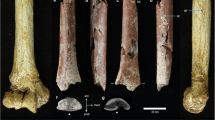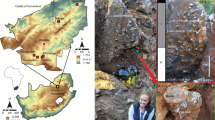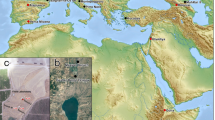Abstract
Currently, it is widely accepted that only one hominin genus, Homo, was present in Pleistocene Asia, represented by two species, Homo erectus and Homo sapiens. Both species are characterized by greater brain size, increased body height and smaller teeth relative to Pliocene Australopithecus in Africa. Here we report the discovery, from the Late Pleistocene of Flores, Indonesia, of an adult hominin with stature and endocranial volume approximating 1 m and 380 cm3, respectively—equal to the smallest-known australopithecines. The combination of primitive and derived features assigns this hominin to a new species, Homo floresiensis. The most likely explanation for its existence on Flores is long-term isolation, with subsequent endemic dwarfing, of an ancestral H. erectus population. Importantly, H. floresiensis shows that the genus Homo is morphologically more varied and flexible in its adaptive responses than previously thought.
This is a preview of subscription content, access via your institution
Access options
Subscribe to this journal
Receive 51 print issues and online access
$199.00 per year
only $3.90 per issue
Buy this article
- Purchase on SpringerLink
- Instant access to full article PDF
Prices may be subject to local taxes which are calculated during checkout







Similar content being viewed by others
References
Morwood, M. J. et al. Archaeology and age of a new hominin from Flores in eastern Indonesia. Nature doi:10.1038/nature02956 431, 1087–1091 (2004)
Wood, B. A. Koobi Fora Research Project, Vol. 4: Hominid Cranial Remains (Clarendon, Oxford, 1991)
Vekua, A. K. et al. A new skull of early Homo from Dmanisi, Georgia. Science 297, 85–89 (2002)
Spoor, C. F. Basicranial architecture and relative brain size of STS 5 (Australopithecus africanus) and other Plio-Pleistocene hominids. S. Afr. J. Sci. 93, 182–186 (1997)
Lieberman, D., Ross, C. F. & Ravosa, M. J. The primate cranial base: ontogeny, function, and integration. Yearb. Phys. Anthropol. 43, 117–169 (2000)
Baba, H. et al. Homo erectus calvarium from the Pleistocene of Java. Science 299, 1384–1388 (2003)
Tobias, P. V. The Skulls, Endocasts and Teeth of Homo habilis (Cambridge Univ. Press, Cambridge, 1991)
McHenry, H. M. & Coffing, K. E. Australopithecus to Homo: Transformations of body and mind. Annu. Rev. Anthropol. 29, 125–166 (2000)
Brown, P. Vault thickness in Asian Homo erectus and modern Homo sapiens. Courier Forschungs-Institut Senckenberg 171, 33–46 (1994)
Bräuer, G. & Mbua, E. Homo erectus features used in cladistics and their variability in Asian and African hominids. J. Hum. Evol. 22, 79–108 (1992)
Santa Luca, A. P. The Ngandong Fossil Hominids (Department of Anthropology Yale Univ., New Haven, 1980)
Weidenreich, F. The skull of Sinanthropus pekinensis: a comparative study of a primitive hominid skull. Palaeontol. Sin. D10, 1–485 (1943)
Brown, P. & Maeda, T. Post-Pleistocene diachronic change in East Asian facial skeletons: the size, shape and volume of the orbits. Anthropol. Sci. 112, 29–40 (2004)
Gabunia, L. K. et al. Earliest Pleistocene hominid cranial remains from Dmanisi, Republic of Georgia: taxonomy, geological setting, and age. Science 288, 1019–1025 (2000)
Kaifu, Y. et al. Taxonomic affinities and evolutionary history of the Early Pleistocene hominids of Java: dento-gnathic evidence. Am. J. Phys. Anthropol. (in the press)
McHenry, H. M. in Evolutionary History of the ‘Robust’ Australopithecines (ed. Grine, F. E.) 133–148 (Aldine de Gruyter, New York, 1988)
Wood, B. A. & Uytterschaut, H. Analysis of the dental morphology of the Plio-Pleistocene hominids. III. Mandibular premolar crowns. J. Anat. 154, 121–156 (1987)
Wood, B. A., Abbott, S. A. & Uytterschaut, H. Analysis of the dental morphology of Plio-Pleistocene hominids. IV. Mandibular postcanine root morphology. J. Anat. 156, 107–139 (1988)
Aiello, A. & Dean, C. An Introduction to Human Evolutionary Anatomy (Academic, London, 1990)
Kennedy, G. E. Some aspects of femoral morphology in Homo erectus. J. Hum. Evol. 12, 587–616 (1983)
Haeusler, M. & McHenry, H. M. Body proportions of Homo habilis reviewed. J. Hum. Evol. 46, 433–465 (2004)
Stern, J. T. J. & Susman, R. L. The locomotor anatomy of Australopithecus afarensis. Am. J. Phys. Anthropol. 60, 279–317 (1983)
Ruff, C. B. Morphological adaptation to climate in modern and fossil hominids. Yearb. Phys. Anthropol. 37, 65–107 (1994)
Jungers, W. L. Lucy's limbs: skeletal allometry and locomotion in Australopithecus afarensis. Nature 297, 676–678 (1982)
Jungers, W. L. Lucy's length: stature reconstruction in Australopithecus afarensis (A.L.288–1) with implications for other small-bodied hominids. Am. J. Phys. Anthropol. 76, 227–231 (1988)
Count, E. W. Brain and body weight in man: their antecendants in growth and evolution. Ann. NY Acad. Sci. 46, 993–1101 (1947)
Martin, R. D. Relative brain size and basal metabolic rate in terrestrial vertebrates. Nature 293, 57–60 (1981)
Jerison, H. J. Evolution of the Brain and Intelligence (Academic, New York, 1973)
McHenry, H. M. in The Primate Fossil Record (ed. Hartwig, C. H.) 401–406 (Cambridge Univ. Press, Cambridge, 2002)
Cavalli-Sforza, L. L. (ed.) African Pygmies (Academic, Orlando, 1986)
Shea, B. T. & Bailey, R. C. Allometry and adaptation of body proportions and stature in African Pygmies. Am. J. Phys. Anthropol. 100, 311–340 (1996)
Roberts, D. F. Climate and Human Variability (Cummings Publishing Co., Menlo Park, 1978)
Merimee, T. J., Zapf, J., Hewlett, B. & Cavalli-Sforza, L. L. Insulin-like growth factors in pygmies. N. Engl. J. Med. 15, 906–911 (1987)
Geffner, M. E., Bersch, N., Bailey, R. C. & Golde, D. W. Insulin-like growth factor I resistance in immortalized T cell lines from African Efe Pygmies. J. Clin. Endocrinol. Metab. 80, 3732–3738 (1995)
Hiernaux, J. The People of Africa (Charles Scribner's Sons, New York, 1974)
Beals, K. L., Smith, C. L. & Dodd, S. M. Brain size, cranial morphology, climate and time machines. Current Anthropology 25, 301–330 (1984)
Rimoin, D. L., Merimee, T. J. & McKusick, V. A. Growth-hormone deficiency in man: an isolated, recessively inherited defect. Science 152, 1635–1637 (1966)
Jaffe, H. L. Metabolic, Degenerative and Inflammatory Disease of Bones and Joints (Lea and Febiger, Philadelphia, 1972)
Seckel, H. P. G. Bird-Headed Dwarfs (Karger, Basel, 1960)
Jeffery, N. & Berkovitz, B. K. B. Morphometric appraisal of the skull of Caroline Crachami, the Sicilian “Dwarf” 1815?–1824: A contribution to the study of primordial microcephalic dwarfism. Am. J. Med. Genet. 11, 260–270 (2002)
Sondaar, P. Y. in Major Patterns in Vertebrate Evolution (eds Hecht, M. K., Goody, P. C. & Hecht, B. M.) 671–707 (Plenum, New York, 1977)
Lomolino, M. V. Body size of mammals on islands: The island rule re-examined. Am. Nat. 125, 310–316 (1985)
Bailey, R. C. & Headland, T. The tropical rainforest: Is it a productive habitat for human foragers? Hum. Ecol. 19, 261–285 (1991)
Köhler, M. & Moyà-Solà, S. Reduction of brain and sense organs in the fossil insular bovid Myotragus. Brain Behav. Evol. 63, 125–140 (2004)
Morwood, M. J., O'Sullivan, P. B., Aziz, F. & Raza, A. Fission-track ages of stone tools and fossils on the east Indonesian island of Flores. Nature 392, 173–176 (1998)
Walker, A. C. & Leakey, R. (eds) The Nariokotome Homo erectus skeleton (Harvard Univ. Press, Cambridge, 1993)
Rak, Y. The Australopithecine Face (Academic, New York, 1983)
Wood, B. A. & Collard, M. The human genus. Science 284, 65–71 (1999)
Johanson, D. C. & White, T. D. A systematic assessment of early African Hominids. Science 202, 321–330 (1979)
Acknowledgements
We would like to thank F. Spoor and L. Aiello for data and discussion. Comments by F. Spoor and D. Lieberman greatly improved aspects of the original manuscript. Conversation with S. Collier, C. Groves, T. White and P. Grave helped clarify some issues. CT scans were produced by CT-Scan KSU, Medical Diagnostic Nusantara, Jakarta. S. Wasisto completed complex section drawings and assisted with the excavation of Sector VII. The 2003 excavations at Liang Bua, undertaken under Indonesian Centre for Archaeology Permit Number 1178/SB/PUS/BD/24.VI/2003, were funded by a Discovery Grant to M.J.M. from the Australian Research Council. UNE Faculty of Arts, and M. Macklin, helped fund the manufacture of stereolithographic models of LB1.Authors contributions P.B. reconstructed the LB1 cranium and was responsible for researching and writing this article, with M.J.M. T.S. directed many aspects of the Liang Bua excavations, including the recovery of the hominin skeleton. M.J.M. and R.P.S. are Principal Investigators and Institutional Counterparts in the ARC project, as well as Co-Directors of the Liang Bua excavations. E.W.S. and Jatmiko assisted T.S., and had prime responsibility for the work in Sector VII. R.A.D. did all of the initial faunal identifications at Liang Bua, including hominin material, and helped clean and conserve it.
Author information
Authors and Affiliations
Corresponding author
Ethics declarations
Competing interests
The authors declare that they have no competing financial interests.
Supplementary information
Supplementary Table 1
Comparative cranial and mandibular dimensions and indices for LB1, A. africanus, early Homo, Homo erectus, and a robust modern H. sapiens sample. (DOC 103 kb)
Supplementary Table 2
Buccolingual crown dimensions for the maxillary and mandibular teeth of LB1, and male and female modern H. sapiens (mm). (DOC 42 kb)
Supplementary Figure 1
First and second principal component scores of linear measurements of the cranial vault in LB1, Indonesian, African and European H. erectus, H. habilis and Australopithecus africanus. (JPG 42 kb)
Supplementary Figure 2
Distal and occlusal views of the isolated LB2 mandibular left P3. Scale bar, 1 cm. (JPG 59 kb)
Supplementary Text File
Captions for supplementary figures and tables, discussion and description of methods used. (DOC 49 kb)
Rights and permissions
About this article
Cite this article
Brown, P., Sutikna, T., Morwood, M. et al. A new small-bodied hominin from the Late Pleistocene of Flores, Indonesia. Nature 431, 1055–1061 (2004). https://doi.org/10.1038/nature02999
Received:
Accepted:
Issue Date:
DOI: https://doi.org/10.1038/nature02999



